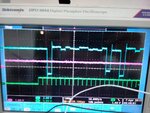Audioguru
Advanced Member level 7

- Joined
- Jan 19, 2008
- Messages
- 9,461
- Helped
- 2,152
- Reputation
- 4,304
- Reaction score
- 2,012
- Trophy points
- 1,393
- Location
- Toronto area of Canada
- Activity points
- 59,764
In his first post he said he is multiplexing his RTDs and the unconnected ones cause the opamps to saturate. I think each RTD should be filtered then the outputs of the filters should be multiplexed.
I have never seen an opamp buffer (follower) like from the Microchip application note as shown here. I show three circuits that produce the same output from a low resistance source:
I have never seen an opamp buffer (follower) like from the Microchip application note as shown here. I show three circuits that produce the same output from a low resistance source:



